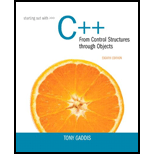
Concept explainers
What is the difference between a class and an instance of the class?
Class:
In object oriented programming, the concept of class is considered as an important feature.
- A class is a collection of data members and member functions, which are used to represent the overall structure of the project.
- The objects are created to access the data members and its functions of the class.
Explanation of Solution
Difference between class and instance of the class:
Some of the differences between class and instance of the class are as follows:
| Class | Instance of the class |
| A class is like a blueprint from which the object is created. | Instance of a class is called as an object. |
| When a class is created, its memory space is not allocated. | After the creation of an instance for the class, memory space is allocated. |
| Class is a logical entity. | Instance of the class is a physical entity. |
| The definition for a class can be created only once. | The object can be created as many times as possible. |
|
Syntax: class Class_name { //class members } |
Syntax: Class_name object; |
Example Program for class and instance of a class:
//Include the required header files
#include<iostream>
#include<string>
using namespace std;
//class name
class Mobile
{
//Access specifier
public:
//Declare a variable
string mobile_name;
};
//Main Function
int main()
{
//create a first object for mobile
Mobile object1;
//Assign a string to the object
object1.mobile_name = "Samsung";
//print the name
cout << object1.mobile_name << endl;
//create a second object for mobile
Mobile object2;
//Assign a string to the object
object2.mobile_name = "Apple";
//print the name
cout << object2.mobile_name << endl;
}
Explanation:
- In the above program, inside a class “Mobile”, declare a variable named “mobile_name”.
- Inside a main function
- Create an object named “object1”.
- Access and assign a string “Samsung” to the data member.
- Print the string.
- Create an object named “object2”.
- Access and assign a string “Apple” to the data member.
- Print the string.
Samsung
Apple
Want to see more full solutions like this?
Chapter 13 Solutions
Starting Out with C++ from Control Structures to Objects (8th Edition)
Additional Engineering Textbook Solutions
Starting Out with Java: From Control Structures through Data Structures (4th Edition) (What's New in Computer Science)
Starting Out with Programming Logic and Design (5th Edition) (What's New in Computer Science)
Web Development and Design Foundations with HTML5 (8th Edition)
Electric Circuits. (11th Edition)
Introduction To Programming Using Visual Basic (11th Edition)
Mechanics of Materials (10th Edition)
- Please solve and answer the questions correctly please. Thank you!!arrow_forwardConsidering the TM example of binary sum ( see attached)do the step-by-step of execution for the binary numbers 1101 and 11. Feel free to use the Formal Language Editor Tool to execute it; Write it down the current state of the tape (including the head position) and indicate the current state of the TM at each step.arrow_forwardI need help on inculding additonal code where I can can do the opposite code of MatLab, where the function of t that I enter becomes the result of F(t), in other words, turning the time-domain f(t) into the frequency-domain function F(s):arrow_forward
 C++ Programming: From Problem Analysis to Program...Computer ScienceISBN:9781337102087Author:D. S. MalikPublisher:Cengage Learning
C++ Programming: From Problem Analysis to Program...Computer ScienceISBN:9781337102087Author:D. S. MalikPublisher:Cengage Learning EBK JAVA PROGRAMMINGComputer ScienceISBN:9781337671385Author:FARRELLPublisher:CENGAGE LEARNING - CONSIGNMENTProgramming Logic & Design ComprehensiveComputer ScienceISBN:9781337669405Author:FARRELLPublisher:Cengage
EBK JAVA PROGRAMMINGComputer ScienceISBN:9781337671385Author:FARRELLPublisher:CENGAGE LEARNING - CONSIGNMENTProgramming Logic & Design ComprehensiveComputer ScienceISBN:9781337669405Author:FARRELLPublisher:Cengage Microsoft Visual C#Computer ScienceISBN:9781337102100Author:Joyce, Farrell.Publisher:Cengage Learning,
Microsoft Visual C#Computer ScienceISBN:9781337102100Author:Joyce, Farrell.Publisher:Cengage Learning, C++ for Engineers and ScientistsComputer ScienceISBN:9781133187844Author:Bronson, Gary J.Publisher:Course Technology Ptr
C++ for Engineers and ScientistsComputer ScienceISBN:9781133187844Author:Bronson, Gary J.Publisher:Course Technology Ptr Systems ArchitectureComputer ScienceISBN:9781305080195Author:Stephen D. BurdPublisher:Cengage Learning
Systems ArchitectureComputer ScienceISBN:9781305080195Author:Stephen D. BurdPublisher:Cengage Learning





